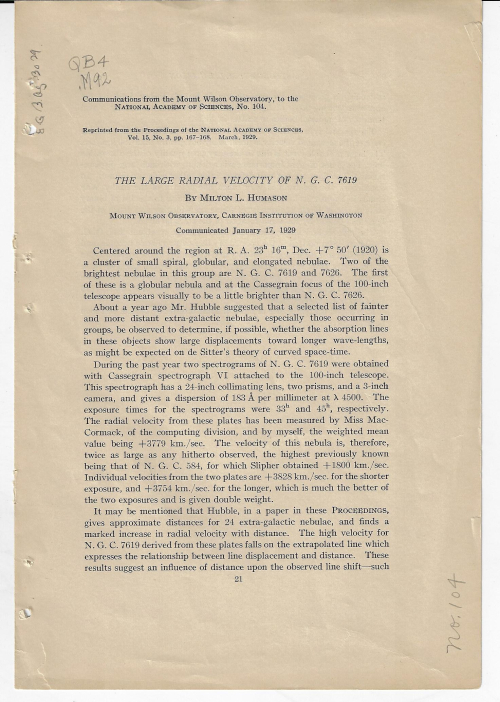Humanson, Milton L. "The Large Radial Velocity of N.G.C. 7619", Communications from the Mount Wilson Observatory, to the National Academy of Science, No. 104; reprinted from the Proceedings of the National Academy of Sciences, vol 15, no. 3, pp 167-168, March 1929. Paginated here as pp (1)-2, plus 2pp blanks. 6 small punched holes for some sort of binding, along with 3 small groups of penciled cataloging numbers. Good copy. Scarce. $[Hold]
- Humason provides significant support for Hubble's 1929 paper (" A Relation between Distance and Radial Velocity among Extra-Galactic Nebulae") which is nearly universally acknowledged as a turning point in 20th c astronomy and the end of the static universe theory as well of course for the foundational work that he co-authored with Hubble in the Velocity-Distance paper of 1931. (It is interesting to note that Fred Hoyle mentioned this as "the famous Hubble-Humason velocity-distance relation", see Helge Krage and Robert Smith, "Who Discovered the Expanding Universe?", in Hist Sci, xli, 2003.) ("...[T]he velocities over the entire range increase directly with distances, and the linear relation holds as closely as distances can be estimated"--E. Hubble, The Realm of the Nebulae, 1936, pg 117.)
- "Satisfied that they had the evidence they needed to promote Hubble’s new observed relationship between velocity and distance, the two decided to publish their findings separately in the proceedings of the National Academy of Sciences. The two papers were communicated to the body of the academy on January 17, 1929. In his one-page [sic] paper, entitled “The Large Radial Velocity of NGC 7619,” Humason laid out the stellar coordinates of the galaxy and wrote briefly about the region of the sky where it sits and of Hubble’s plan to see if a relationship between velocity and distance could be observed. He mentioned Slipher’s previous velocity for NGC 584 and hinted at Hubble’s velocity to distance relationship that followed immediately after his own. Hubble’s paper, “A Relation Between Distance and Radial Velocity Among Extra-Galactic Nebulae,” exposed the world for the first time to the notion that the universe was expanding..." --Ronald Veller, The Muleskinner and the Stars, the Life and Times of Milton La Salle Humason, Springer, 2016
“To establish his now-famous relation between radial velocity and distance, Hubble needed data for many more extragalactic nebulae. In 1929, Humason observed a radial velocity for the galaxy NGC 7619...twice as great as the highest previously known galaxy” the results of the observation published in this (offered) paper. Encyclopedia of Cosmology (Routledge Revivals): Historical, Philosophical ...edited by Norriss S. Hetherington , pg 298
“What is certain, is that Hubble had held his paper for over a year before submitting it for publication, 96 a delay probably due to a desire of Hubble to have available some radial velocity measurements by Humason...In 1929 he was resolved to throw his relation "into the blue", with himself securing the distances to the galaxies and Humason the radial velocities. Hubble, then, had presented evidence for the existence of a linear redshift distance relation and further observations would reveal if it could be carried farther into extragalactic space...” The Origins of the Velocity-Distance Relation", R. W. Smith, pg 150-151, Journal for the History of Astronomy, 1979.
“Hubble discovered the linear law connecting redshifts and distances, but this does not mean that he also discovered the expansion of the universe. Nowhere in his paper did he conclude that the galaxies were actually receding from us or otherwise suggest that the universe was expanding. He did present the law in terms of velocities, but he referred to ‘apparent velocities’, that is, redshifts that could be conveniently transformed to velocities by means of the Doppler formula but for which other interpretations might be equally valid. ‘We [Hubble and Humason] use the term “apparent” in order to emphasize the empirical features of the correlation,’ he wrote to de Sitter in 1931. ‘The interpretation, we feel, should be left to you and the very few others who are competent to discuss the matter with authority.’ Humason followed Hubble in his cautious attitude and wrote that the observations could be explained ‘both by the apparent slowing-down of light vibrations with distance and by a real tendency of material bodies to scatter in space.”(footnote 64, this paper).--Kragh, Helge S. Conceptions of Cosmos : From Myths to the Accelerating Universe: A History of Cosmology. Oxford, 2007, pg 146 (“Conception of Cosmos”)
"Credits Hubble [in this paper] with having suggested this test of the expanding universe theory some time earlier”--Paul S Braterman , From Stars to Stalagmites (World Scientific, 2012, pg 283) ("It may be mentioned that Hubble, in a paper in these PROCEEDINGS, gives approximate distances for 24 extra-galactic nebulae, and finds a marked increase in radial velocity with distance. The high velocity for N. G. C. 7619 derived from these plates falls on the extrapolated line which expresses the relationship between line displacement and distance.")
Humason's paper appears just four pages before Hubble's famous 1929 paper in which appears the iconic velocity-distance graph (figure 1, pg 172, same issue as the above). See Marcia Bartusiak, The Day We Found the Universe, pg 282.
“This was the first time that Humason used the formula velocity equals distance time K, or more significantly distance equals velocity divided by K” and thus found that NGC 7619 was moving at the “breakneck speed” of 3,779 kilometers/hour. George Johnson, Miss Leavitt's Stars: The Untold Story of the Woman Who Discovered How to ...pg 105





Comments